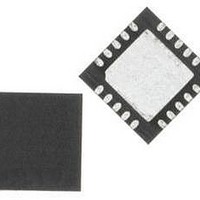C8051F336-GMR Silicon Laboratories Inc, C8051F336-GMR Datasheet - Page 106

C8051F336-GMR
Manufacturer Part Number
C8051F336-GMR
Description
Microcontrollers (MCU) 16KB 10ADC 10DAC 768Ram MCU Lead Free
Manufacturer
Silicon Laboratories Inc
Datasheet
1.C8051F336-GM.pdf
(226 pages)
Specifications of C8051F336-GMR
Processor Series
C8051F3x
Core
8051
Data Bus Width
8 bit
Program Memory Type
Flash
Program Memory Size
16 KB
Data Ram Size
768 B
Interface Type
I2C, SPI, UART
Maximum Clock Frequency
25 MHz
Number Of Programmable I/os
17
Number Of Timers
4
Operating Supply Voltage
2.7 V to 3.6 V
Maximum Operating Temperature
+ 85 C
Mounting Style
SMD/SMT
Package / Case
QFN-20
3rd Party Development Tools
KSK-SL-TOOLSTICK, PK51, CA51, A51, ULINK2
Development Tools By Supplier
C8051F336DK
Minimum Operating Temperature
- 40 C
On-chip Adc
10 bit
On-chip Dac
10 bit
Package
20QFN
Device Core
8051
Family Name
C8051F336
Maximum Speed
25 MHz
Ram Size
768 Byte
Operating Temperature
-40 to 85 °C
Lead Free Status / Rohs Status
Details
Available stocks
Company
Part Number
Manufacturer
Quantity
Price
Company:
Part Number:
C8051F336-GMR
Manufacturer:
SILICON
Quantity:
100
Part Number:
C8051F336-GMR
Manufacturer:
SILICON LABS/芯科
Quantity:
20 000
Company:
Part Number:
C8051F336-GMR
Manufacturer:
SILICON
Quantity:
13 282
C8051F336/7/8/9
18. Power Management Modes
The C8051F336/7/8/9 devices have three software programmable power management modes: Idle, Stop,
and Suspend. Idle mode and Stop mode are part of the standard 8051 architecture, while Suspend mode
is an enhanced power-saving mode implemented by the high-speed oscillator peripheral.
Idle mode halts the CPU while leaving the peripherals and clocks active. In Stop mode, the CPU is halted,
all interrupts and timers (except the Missing Clock Detector) are inactive, and the internal oscillator is
stopped (analog peripherals remain in their selected states; the external oscillator is not affected). Sus-
pend mode is similar to Stop mode in that the internal oscillator and CPU are halted, but the device can
wake on events such as a Port Mismatch, Comparator low output, or a Timer 3 overflow. Since clocks are
running in Idle mode, power consumption is dependent upon the system clock frequency and the number
of peripherals left in active mode before entering Idle. Stop mode and Suspend mode consume the least
power because the majority of the device is shut down with no clocks active. SFR Definition 18.1 describes
the Power Control Register (PCON) used to control the C8051F336/7/8/9's Stop and Idle power manage-
ment modes. Suspend mode is controlled by the SUSPEND bit in the OSCICN register (SFR Definition
19.3).
Although the C8051F336/7/8/9 has Idle, Stop, and Suspend modes available, more control over the device
power can be achieved by enabling/disabling individual peripherals as needed. Each analog peripheral
can be disabled when not in use and placed in low power mode. Digital peripherals, such as timers or
serial buses, draw little power when they are not in use. Turning off oscillators lowers power consumption
considerably, at the expense of reduced functionality.
18.1. Idle Mode
Setting the Idle Mode Select bit (PCON.0) causes the hardware to halt the CPU and enter Idle mode as
soon as the instruction that sets the bit completes execution. All internal registers and memory maintain
their original data. All analog and digital peripherals can remain active during Idle mode.
Idle mode is terminated when an enabled interrupt is asserted or a reset occurs. The assertion of an
enabled interrupt will cause the Idle Mode Selection bit (PCON.0) to be cleared and the CPU to resume
operation. The pending interrupt will be serviced and the next instruction to be executed after the return
from interrupt (RETI) will be the instruction immediately following the one that set the Idle Mode Select bit.
If Idle mode is terminated by an internal or external reset, the CIP-51 performs a normal reset sequence
and begins program execution at address 0x0000.
Note: If the instruction following the write of the IDLE bit is a single-byte instruction and an interrupt occurs
during the execution phase of the instruction that sets the IDLE bit, the CPU may not wake from Idle mode
when a future interrupt occurs. Therefore, instructions that set the IDLE bit should be followed by an
instruction that has two or more opcode bytes, for example:
// in ‘C’:
PCON |= 0x01;
PCON = PCON;
; in assembly:
ORL PCON, #01h
MOV PCON, PCON
If enabled, the Watchdog Timer (WDT) will eventually cause an internal watchdog reset and thereby termi-
nate the Idle mode. This feature protects the system from an unintended permanent shutdown in the event
of an inadvertent write to the PCON register. If this behavior is not desired, the WDT may be disabled by
106
// set IDLE bit
// ... followed by a 3-cycle dummy instruction
; set IDLE bit
; ... followed by a 3-cycle dummy instruction
Rev.1.0











